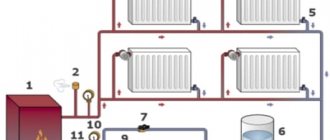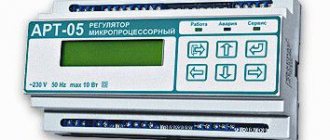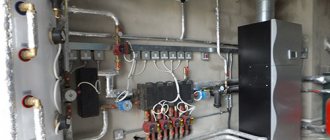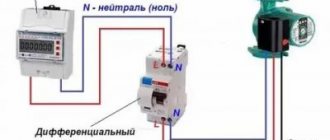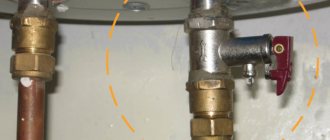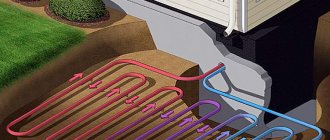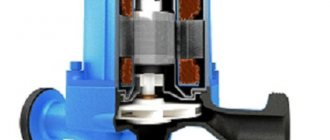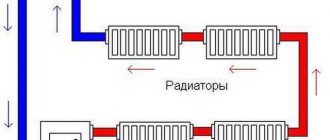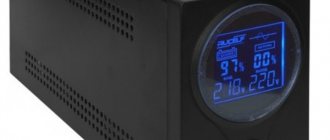What are the benefits of pump heating systems?
30 years ago, so-called steam heating was common in private homes, where the coolant circulated through pipes and radiators by gravity, and the heat source was a gas boiler or wood stove. Pumps for pumping water were used in district heating networks. When compact circulation pumps for heating appeared, they migrated to private housing construction, as they provided the following advantages:
- The speed of coolant movement has increased. The heat generated by the boiler has become faster delivered to the radiators and transferred to the premises.
- Accordingly, the process of heating the house has accelerated significantly.
- The higher the flow rate, the greater the throughput of the pipe. This means that the same amount of heat can be delivered to rooms through lines of smaller diameter. Simply put, the pipelines have become half the size thanks to the forced circulation of water from the pump, which is cheaper and more practical.
- Highways can now be laid with a minimum slope and water heating circuits can be made as complex and extensive as desired. The main thing is the correct selection of the pumping unit in terms of power and pressure created.
- The household circulation pump for heating has made it possible to organize underfloor heating and more efficient closed systems operating under pressure.
- It was possible to remove from view the ubiquitous pipes that run through the rooms and do not always harmonize with the interior. Increasingly, heating communications are laid in walls, under floor coverings and behind suspended (suspended) ceilings.
Note. A minimum slope of 2-3 mm per 1 m of pipeline is needed to empty the network in case of repair or maintenance. Previously, it was made at least 5 mm / 1 m.p.
Pumping systems also have disadvantages. This is a dependence on electricity and its consumption by the pumping unit during the heating season. Therefore, if there are frequent power outages, the circulation pump must be installed together with an uninterruptible power supply unit or connected to an electric generator. The second drawback is not critical; if you select the power of the device correctly, then the electricity consumption will be acceptable.
Leading manufacturers of heating equipment, such as Grundfos or Wilo, have developed new models of units that can save energy. For example, if you buy and install an Alpfa2 circulation pump from the Grundfos brand, it will automatically change its performance depending on the needs of the heating system. True, its price starts from 120 USD. e.
New generation circulation units from Grundfos – models Alpfa2 and Alpfa2L
Features of circulation pumps
In systems with a forced circulation system, a pump is installed to increase heat capacity. Correct installation of the circulation pump in the heating system allows you to change the heat that is transferred depending on the outside temperature while maintaining stability of the heating in the room.
There are two types of such equipment : with a dry and wet rotor. Devices with a dry rotor have increased efficiency (about 80%), do not create much noise and require constant maintenance. The operation of a device with a wet rotor is different; it has a low efficiency (about 50%), is noisier, and its performance is sufficient to heat any private home.
30 years ago, homes used so-called vertical central heating, which was powered by liquid circulating through pipes, and the heat source was a gas boiler or wood-burning stove. Now there has been a transition to the construction of private housing using heaters with a pump, which has the following advantages:
- The coolant speed increases.
- The heat produced by the boiler is quickly delivered to the radiators and returned to its place.
- The heating process is significantly accelerated.
- The speed is higher, so the same amount of heat can be supplied to pipes with a smaller diameter. In other words, a pipe with forced circulation of water in a pump is cheaper. The barrel can now be wrapped with minimal deflection and added complexity. The main thing is to make the correct selection of the pump unit and set the pressure.
- An internal pump for circulating water in the heating system made it possible to have heated floors and efficient closed systems operating under high pressure.
- We managed to remove the pipes that run along the walls and do not always harmonize with the kitchen interior. Nowadays, heating lines are built into the walls, under the floor and behind the suspended ceiling.
As the main disadvantage of the pumps, it can be noted that if there is a need to frequently turn off the circulation pump, a generator must be installed or connected.
Where to install the pump - supply or return
Despite the abundance of information on the Internet, it is quite difficult for the user to understand how to correctly install a heating pump in order to ensure forced circulation of water in the system of their own home. The reason is the inconsistency of this information, which causes constant debate on thematic forums. Most of the so-called specialists claim that the unit is installed only on the return pipeline, citing the following conclusions:
- the coolant temperature in the supply is much higher than in the return, so the pump will not last long;
- The density of hot water in the supply line is less, so it is more difficult to pump;
- The static pressure in the return line is higher, which makes the pump easier to operate.
Interesting fact. Sometimes a person accidentally ends up in a boiler room that provides central heating for apartments, and sees the units there embedded in the return line. After this, he considers this solution to be the only correct one, although he does not know that in other boiler houses centrifugal pumps can also be installed on the supply pipe.
We respond to the above statements point by point:
- Household circulation pumps are designed for a maximum coolant temperature of 110 °C. In a home heating network it rarely rises above 70 degrees, and the boiler will not heat the water more than 90 °C.
- The density of water at 50 degrees is 988 kg/m³, and at 70 °C – 977.8 kg/m³. For a unit that develops a pressure of 4-6 m of water column and is capable of pumping about a ton of coolant in 1 hour, the difference in the density of the transported medium is 10 kg/m³ (the volume of a ten-liter canister) is simply negligible.
- In practice, the difference in static pressure of the coolant in the supply and return lines is equally insignificant.
Hence the simple conclusion: circulation pumps for heating can be installed both in the return and supply pipelines of the heating system of a private house. This factor will not in any way affect the performance of the unit or the heating efficiency of the building.
Boiler room made by our expert Vladimir Sukhorukov. There is convenient access to all equipment, including pumps.
The exception is cheap solid fuel direct combustion boilers that are not equipped with automation. When overheated, the coolant in them boils, since burning wood cannot be extinguished at once. If the circulation pump is installed on the supply side, then the resulting steam mixed with water enters the housing with the impeller. The further process looks like this:
- The impeller of the pumping device is not designed to move gases. Therefore, the performance of the device decreases sharply, and the flow rate of the coolant drops.
- Less cooling water enters the boiler tank, causing overheating to increase and even more steam to be produced.
- An increase in the amount of steam and its entry into the impeller leads to a complete stop of the coolant movement in the system. An emergency situation occurs and, as a result of an increase in pressure, a safety valve is activated, releasing steam directly into the boiler room.
- If no measures are taken to extinguish the firewood, the valve cannot cope with the pressure release and an explosion occurs with the destruction of the boiler shell.
For reference. In cheap heat generators made of thin metal, the response threshold of the safety valve is 2 Bar. In higher quality TT boilers, this threshold is set at 3 Bar.
Practice shows that no more than 5 minutes pass from the start of the overheating process to the valve activation. If you install a circulation pump on the return pipe, then steam will not enter it and the time period before an accident will increase to 20 minutes. That is, installing the unit on the return line will not prevent an explosion, but will delay it, which will give more time to fix the problem. Hence the recommendation: it is better to install pumps for boilers running on wood and coal on the return pipeline.
For well-automated pellet heaters, the installation location does not matter. You will learn more information on the topic from our expert’s video:
Where is it usually recommended to install the pump?
You can often find information on the Internet that it is better to install the pump on the return line, and of course, there are certain explanations for this:
- If you put the pump on the supply, the pump will fail faster, because the temperature is higher here, but if you put it on the return, the unit will last for many years;
- At supply, the density of water is less and it is difficult to pump;
- The return pressure is higher, and therefore the pump is easier to work with.
But all the above arguments are considered not entirely correct and we will figure out why.
- Firstly, the permissible temperature for pumps is +110 - +115 degrees, but in a heating system, the temperature usually reaches 80 o and in rare cases 90 o. Therefore, the moment where to install the pump on the return or supply has no influence.
- The density of water also does not affect, because the difference between this parameter at a temperature of 50° and 80° is so small that it will not affect the operation of the unit in any way.
- The pressure difference between the value in the coolant and the main line is also very small, which makes no sense to calculate it.
Based on this, we draw the only conclusion that circulation pumps can be installed both on the supply and return side. And where it will be installed will not affect its operation and durability in any way. The main condition that must be met when installing a boiler is ease of maintenance.
Installation diagrams in various types of systems
To begin with, let’s clarify the place where to install the flow pump, which circulates water through the boiler and forcibly directs it to the radiators of the heating system. According to our expert Vladimir Sukhorukov, whose experience is trustworthy, the installation location must be chosen in such a way that the unit is convenient to maintain. On the supply side it should be located after the safety group and shut-off valves, as shown in the installation diagram:
In order for the unit to be removed and serviced, shut-off valves must be installed on the sides
On the return line, the pump must be placed directly in front of the heat generator, and in tandem with a filter - a mud trap, so that you do not have to buy and install extra taps. The wiring diagram for the pumping unit looks like this:
When installing on the return line, it is better to place the mud collector in front of the pump unit
Recommendation. A circulation pump can be installed in this way in both a closed and an open heating system, there is not much difference. The statement also applies to the collector system, where the coolant moves to the radiators through separate connections connected to the distribution comb.
A separate issue is an open heating system with a circulation pump, capable of operating in 2 modes - forced and gravity. The latter is useful for homes where power outages often occur, and the owners’ income does not allow them to buy an uninterruptible power supply unit or a generator. Then the device with shut-off valves must be installed on the bypass, and a tap must be inserted into a straight line, as shown in the diagram:
This scheme can operate in forced and gravity mode
Important point. On sale there are ready-made bypass units with a pump, where instead of a tap on the flow there is a check valve. Such a solution cannot be called correct, since a spring-type check valve creates a resistance of the order of 0.08-0.1 Bar, which is too much for a gravity heating system. Instead, you can use a petal valve, but it must be installed only in a horizontal position.
Finally, we will explain how to install and connect a circulation pump to a boiler that burns solid fuel. As mentioned above, it is better to place the unit on the line coming from the heating system to the heat generator, as shown in the diagram:
As you can see, the piping uses a pump connection to the boiler circulation circuit with a bypass and a three-way mixing valve. The important role of these piping elements is described in detail in the manual on connecting solid fuel boilers.
Installation rules
The design of a household circulation pump from any manufacturer provides for its fastening to pipelines or shut-off valves using union nuts (American). This allows it to be quickly dismantled if necessary, for example, for replacement or repair. When installing the pump unit, follow these recommendations:
- Place the device on any sections of pipelines - horizontal, vertical or inclined, but with one condition: the rotor axis must be in a horizontal position. That is, installation “head down” or up is unacceptable.
- Please note that the plastic box with electrical contacts is located on top of the case, otherwise it will be flooded with water in the event of an accident. Yes, and servicing the product will not be easy. This is easy to achieve: unscrew the screws securing the casing and turn it to the desired angle.
- Remember to follow the flow direction indicated by the arrow on the housing.
- So that the product can be removed without emptying the system, install shut-off valves before and after it, as shown in the diagrams in the previous section.
A visual aid showing what position the pump unit should be in
Advice. It so happened that the load from the weight of the circulation unit will fall on 1 or 2 ball valves (depending on the orientation of the area in space). Hence the recommendation: do not save money and buy high-quality shut-off valves, whose body will not crack over time from mechanical stress.
Rules for installation in a heating system
Regardless of the type of design of the circulation pump, it is installed on a pipeline or shut-off valve using American union nuts.
This makes it possible to quickly dismantle in case of repair or replacement of the device. There are the following recommendations for installing a circulation pump:
The unit can be embedded in any part of the pipeline - horizontal, vertical or inclined
The main thing is to maintain the horizontal orientation of the rotor axis (the head should never look down or up). It is very important that the plastic container with electrical contacts is placed on top of the case, otherwise it will be flooded with water during an accident. In addition, this will significantly complicate the maintenance of the device.
This is quite simple to do by unscrewing the screws securing the box and turning it in the desired direction. The arrow on the pump body indicates the direction of coolant flow, which is important to observe. To simplify maintenance and repair of the device, it is recommended to equip it with shut-off valves on both sides. This will allow you to avoid draining water from the circuit during dismantling.
With this installation scheme for the heating pump, the entire load from its mass falls on 1 or 2 ball valves: their number depends on the spatial orientation of the device. Therefore, it is better not to save money, but to purchase high-quality shut-off valves, the body of which has good mechanical strength.
About installing additional units
As a rule, in a closed or open radiator heating system, where the heat source is a single boiler, it is enough to install one circulation pump. In more complex schemes, additional units are used for pumping water (there may be 2 or more of them). They are placed in the following cases:
- when more than one boiler installation is used to heat a private house;
- if a buffer tank is involved in the piping scheme;
- the heating system has several branches serving various consumers - radiators, heated floors and an indirect heating boiler;
- the same, using a hydraulic separator (hydraulic arrow);
- for organizing water circulation in underfloor heating circuits.
Correct wiring of several boilers operating on different types of fuel requires that each of them have its own pumping unit, as shown in the diagram for the joint connection of an electric and TT boiler. How it functions is described in our other article.
Connecting an electric and TT boiler with two pumping devices
In a circuit with a buffer tank, it is necessary to install an additional pump, because it involves at least 2 circulation circuits - boiler and heating.
The buffer tank divides the system into 2 circuits, although in practice there are more of them
A separate story is a complex heating scheme with several branches, implemented in large cottages with 2-4 floors. Here, from 3 to 8 pumping devices can be used (sometimes more), supplying coolant floor by floor and to different heating devices. An example of such a circuit is shown below.
Finally, a second circulation pump is installed when heating the house with water-heated floors. Together with the mixing unit, it performs the task of preparing coolant with a temperature of 35-45 ° C. The operating principle of the circuit presented below is clearly described in a separate material.
This pumping unit forces coolant to circulate through the heating circuits of underfloor heating.
Reminder. Sometimes pumping devices do not need to be installed for heating at all. The fact is that most electric and gas wall-mounted heat generators are equipped with their own pumping units built inside the housing.
Why do you need a pump in a heating system?
In autonomous heating systems, heat transfer is carried out using water. Due to the low heat transfer of the liquid, its constant movement is required. The pump in the heating system of a private house ensures constant circulation of the heating agent.
There may be several pumps in the heating circuit, but they all perform the same tasks: they force water to move in a given direction. As a rule, one is installed on the main line (supply or return). If you use floor heating or a hot water supply circuit, install additional ones with lower productivity. In addition, pumps can be used to increase water pressure when there is not enough pressure in the water supply.
Connecting the circulation pump to the electrical network
There are several ways to connect power to the device:
- through a conventional differential machine;
- with thermostat control;
- connection to the network together with an uninterruptible power supply unit (UPS);
- powering the unit from the boiler automation.
Warning. Often, homeowners simply plug the pump into a regular outlet, connecting the wires to a purchased plug. We cannot recommend this approach, because connection without grounding and a safety device is dangerous. If there is a problem with the device or if it is filled with water, you risk receiving an electric shock.
Typical connection diagram with a differential circuit breaker
The first connection diagram is quite simple and any user can assemble it with his own hands. You will need an 8 A differential circuit breaker, wires and contacts. Connect to grounding both in this circuit and in all others.
To automatically stop the movement of the coolant when cooling to a certain temperature, an electrical circuit is used to connect a circulation pump with a thermostat. The latter is attached to the supply pipeline and breaks the power supply circuit when the water temperature drops below a set value.
Connecting a phase wire to the pump through an overhead thermostat
Attention! To ensure that the thermostat does not lie and turns off the circulation in time, it must be attached to a metal section of the line. Polymers do not transfer heat well, so when mounted on a plastic pipe, the device will not work correctly.
There are no difficulties in connecting the power supply through a UPS, for which the latter has special connectors. The heat generator itself should also be connected to them if it needs electricity. But connecting the pump to the boiler control panel or to its automation is a more complicated procedure. It is advisable to have knowledge and skills in the field of electrical engineering.
The boiler is also connected to the uninterruptible unit if it needs electricity
At what speed should the pump in the heating system operate?
The purpose of forced circulation is to effectively heat the house through the reliable delivery of heat to all consumers of the system, right up to the furthest radiator. To do this, the pumping unit must develop the required pressure (otherwise known as pressure), which is ideally calculated by design engineers based on the hydraulic resistance of the pipeline network.
Most household pumps have from 3 to 7 rotor speeds, due to which the performance and pressure generated can be increased or decreased. In order not to torment you with hydraulic calculations, we offer the following method for selecting the optimal speed:
- Find a laser surface thermometer (pyrometer). Put the heating system into operating mode.
- Measure the surface temperature of the pipe at the inlet and outlet of the boiler.
- If the temperature difference is more than 20 °C, increase the rotor speed. After 30 minutes, repeat the measurement.
- When the temperature difference is less than 10 °C, the water flow rate must be reduced. The goal is to achieve a delta between supply and return of about 15 °C.
The minimum number of rotor speeds is 3, but sometimes 7 or more
Advice. Do not switch the pump to a different circulation speed “on the fly”. Disconnect it from the network, move the regulator to a different position, and then put it back into operation.
You can do without a pyrometer when thermometers are installed on the supply and return lines. If the adjustment limits do not allow you to enter the range of 10-20 °C temperature difference, your system is not working efficiently due to an incorrectly selected circulation pump. Too cold return water increases the load on the boiler and increases fuel consumption. Water that is too hot means that it flows too quickly and does not have time to transfer heat to the heating devices.
The leading European brand Grundfos offers the latest generation Alpfa3 circulation pumps, which can independently select performance depending on the load and thus adapt the work to changing conditions. With their help, you can even balance the heating system, which our expert will tell you about in the next video:
Our gallery of works
Installation of a circulation pump
Installation and replacement of a circulation pump in a finished heating system is carried out by cutting the compressor into a section of pipe next to the riser. In this case, if the equipment is mounted on the supply line, the shut-off valves are placed in front of the housing. If on the “return” - after. Thus, at any time it will be possible to de-energize the branch without draining the coolant from the circuit. The unit is secured with union nuts, which, if necessary, can be quickly loosened to dismantle the device.
In the future heating system, all distribution pipes are first installed taking into account the developed circuit, and then the pump itself is installed. The procedure is similar to that described above. The block can be placed in any position. The main thing is that the flow direction corresponds to the schematic arrow on the body. In addition, the motor rotor must always remain horizontal.
How to call a specialist to install a heating pump?
Installation of heating pumps by our organization is accompanied by an official guarantee of up to 3 years for all work performed. In addition, an agreement is drawn up defining the rights and obligations of the parties. We strive to provide qualified assistance on transparent terms and with minimal costs for the customer, we offer a loyal price list and a wide coverage map, right up to the most remote settlements of the Moscow region.
To order this service, just call us at the contact number, contact the operator, and outline the upcoming details. In accordance with the information provided, a specialized foreman or team will arrive at the site, depending on the amount of work. You yourself will name a convenient date and time for the specialists’ visit. The second option is to use the feedback form by entering contact information on the website.
Reviews about us
Valentin Yurievich 05/31/2020
Master: Valery Belov
Grade:
The heating pump was replaced. High-quality and accurate implementation. I did everything without any problems. Five points!
Read more
m. Kozhukhovskaya
Stanislav Antonovich 01/12/2020
Master: Artur Sergeev
Grade:
I contacted you to install a heating pump on a manifold group for a heated floor system. I was very pleased with Arthur’s work, he’s a good guy, he understands everything. I was completely satisfied with the result of the work, thank you!
Read more
m. Khoroshevskaya
Vera Vyacheslavovna 12/16/2019
Master: Maxim Makarov
Grade:
The pump stopped working and needed to be replaced. I called several numbers, but they were able to send me a person today. Within an hour the technician was at my place and changed the pump. I’m very glad that they work so quickly here, they helped on time!
Read more
m. Academician Yangelya Street
Nina Sergeevna 10/04/2019
Master: Yaroslav Korolev
Grade:
I called this company, I needed to install a pump for a heating boiler. A master arrived and helped me buy the pump itself. Got it done quickly. I can recommend this company!
Read more
m. Mozhaiskaya
show more

